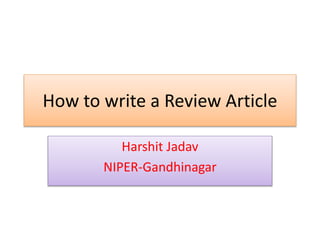
How to Write a Review Article
- 1. How to write a Review Article Harshit Jadav NIPER-Gandhinagar
- 2. What is a review article? • A critical, constructive analysis of the literature in a specific field through summary, classification, analysis, comparison. • A scientific text relying on previously published literature or data. • New data from the author’s experiments are not presented (with exceptions: some reviews contain new data)
- 3. What is the function of a review article? • To organize literature • To evaluate literature • To identify patterns and trends in the literature • To synthesize literature • To identify research gaps and recommend new research areas
- 4. Who is the audience of review articles? • Experts in specific research areas • Students or novice researchers • Decision-makers
- 5. Which types of review articles exist? • Narrative review: Selected studies are compared and summarized on the basis of the author’s experience, existing theories and models. Results are based on a qualitative rather than a quantitative level. • Best evidence review: A focus on selected studies is combined with systematic methods of study- selection and result exploration. • Systematic review: Findings from various individual studies are analyzed statistically by strict procedures. Meta-Analyses are used to pool the results of individual studies
- 6. How long is a review article? • Review articles vary considerably in length. Narrative reviews may range between 8,000 and 40,000 words (references and everything else included). • Systematic reviews are usually shorter with less than 10,000 words.
- 7. Elements of a review article Title: between eight to 12 words • Helping readers to decide whether they should read the text or not List of authors: Declare intellectual ownership of the work, • provide contact information Abstract: Informs about the main objectives and result of the review article • usually 200 to 250 words
- 8. Introduction: Provides information about the context, indicates the motivation for the review, defines the focus, the research question and explains the text structure • Between 10% and 20% of the core text
- 9. Body: Main Part of the Review Article • Methodological approaches • Models or theories • Extent of support for a given thesis • Studies that agree with another versus studies that disagree • Chronological order • Geographical location • 70 to 90% of the core text
- 10. Conclusions • Answer the research question set in the introduction • 5 to 10% of the core text References • Shows interested readers how to find the literature mentioned in the text. • A range between 50-100 references
- 11. Preparing a review article in 18 steps 1. Narrow the topic, define a few research questions or hypotheses 2. Search for literature sources, refine topic and research questions during the search 3. Read, evaluate, classify and make notes 4. Redefine the focus and the research questions, define the take-home message 5. Compose a preliminary title
- 12. 6. Find a structuring principle for the article (e.g. Chronological, subject matter, experimental procedure) 7. Prepare an outline, find headings for the sections in the text body 8. Plan the content of each paragraph in the different sections 9. Prepare tables, concept maps, figures
- 13. 10. Draft the methods section (if needed) 11. Draft the body sections 12. Draft the conclusions 13. Draft the introduction 14. Draft the abstract 15. Revise drafts of different sections, abstract & title, tables, figures & legends 16. Revise citations and references 17. Correct grammar, spelling, punctuation 18. Adjust the layout
